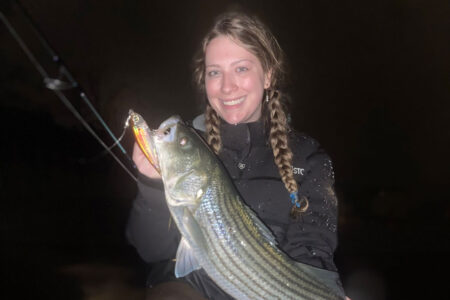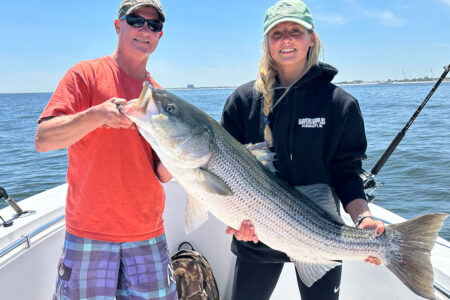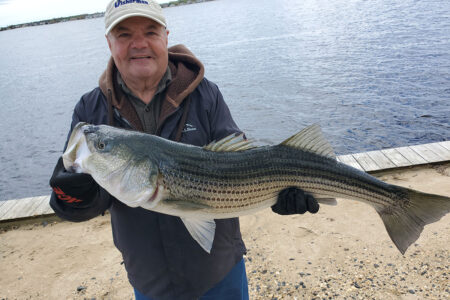What’s not to like – generally calm water, light tackle, small lures and the first stripers of the season?
I’ve fished in the suds and I’ve been in a boat in late March and early April, and I’ll take the surf anytime when it’s cold and raw. Sure, you can dress warm for both, but you don’t move much in a boat, and the less you move the colder you get. I offer this opinion because I can remember many early season boat trips for stripers, and two extremes come to mind: very cold or pleasant days. One cold day in particular jumps out at me. It was late March, the air temperature was 29 degrees, and the wind, although not gusty, was persistent. Rich Lazar enjoyed good catches all week in Manhasset Bay with help from tame weather, and we were buoyed by a forecast of sun, light winds, and a 40-degree temperature. A surprise back-door cold front ended any hopes that the forecast would hold up. It was ridiculously uncomfortable, but we caught fish. I guess the moral of the story is not to be put-off by fickle early spring weather if you enjoy being first on your block to catch some stripers. Perhaps it’s cabin fever or maybe just insanity, but I enjoy making early trips regardless of the weather or the venue. What’s not to like? Let’s see: generally calm water, light tackle, small lures, and wiggling things with stripes. Not a bad combination.
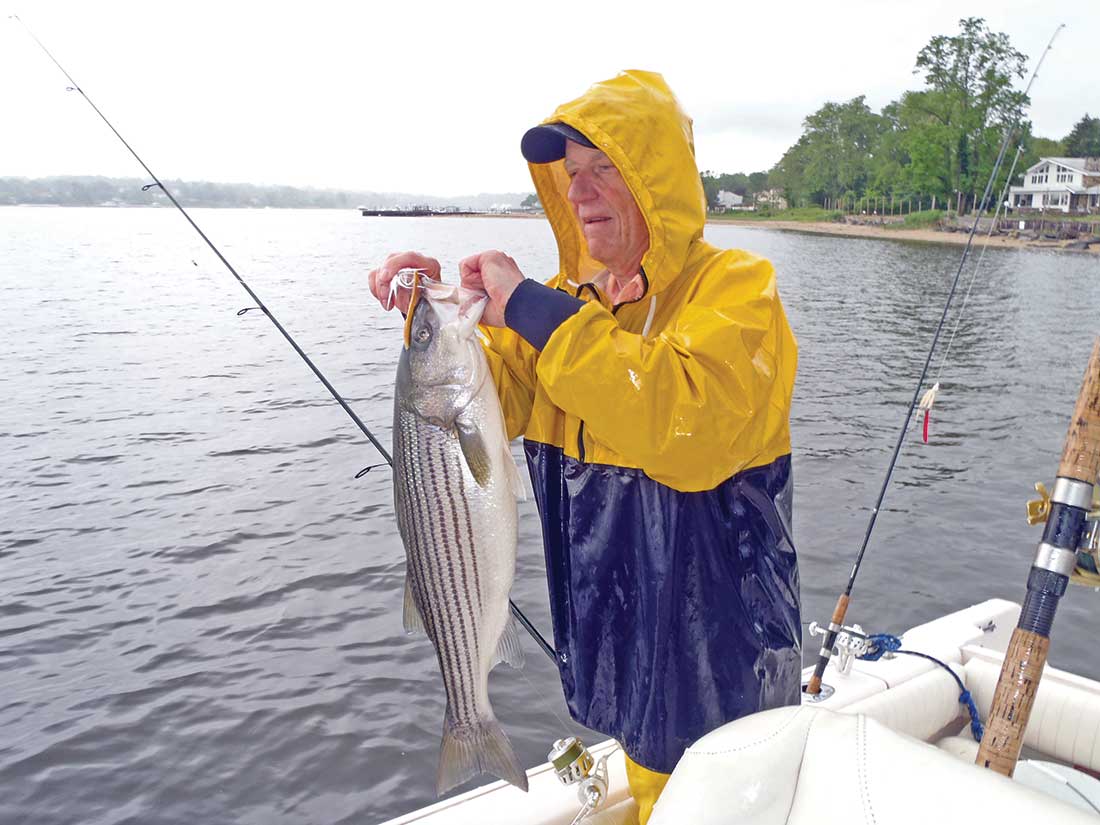
Hudson River Stock
Perhaps we can set the record straight. Contrary to the opinion of many, all Hudson River stripers don’t spend the winter in the Hudson River. Sure, there are some river residents, but the bulk of the fish spend the winter in the deep waters of Long Island Sound, with other minor groups spread out in deeper parts of the South Shore bays from Jamaica to Shinnecock. If they needed to migrate from the river to our harbors and creeks, they wouldn’t arrive so quickly after the first few warm spring days, and the Hudson River would be very crowded indeed. However, with many schools wintering in deeper Sound areas, they can go shallow into the harbors with a few beats of their tails.
In general, the smaller stripers, or school fish, respond first. The exact reasons for this reality can’t be quantified, but it is probably related to the inshore migration of sand eels. Larger fish can remain in deeper water and eat larger foods such as bergalls, blackfish, lobsters, and crabs. This seems true since many anglers have experienced that when schools of adult bunker enter the harbors, larger stripers arrive with them. In the 1990s, when the striper population was at a peak, many anglers indulged in live-lining adult bunker as early as late March; this author included. However, the current smaller striper population doesn’t support early live-lining because feeding competition among large fish is much lower now and they can stay deep longer.
Stay Home!
As far as I can tell, there is spring action in all harbors although the earliest action is far west. However, by mid-April I’ve caught stripers from Little Neck to Port Jefferson Harbors. So, I advise anglers to fish their home turf since it’s always easier to produce when you know the lay of the land and where the local bait hangs out. Remember that bait tends to congregate according to their survival needs, so while they bunch up in some areas, they will be totally absent in others. Finally, if you fish in your home waters you are aware how patterns change through the season.
Seasonal Contradictions
For example, if your harbor tends to produce best on high incoming tide in spring, I can almost promise you that in the fall it will be low outgoing. Why you ask? I don’t know for sure, but if I were to guess I’d say it’s because spring sand eels behave differently from fall peanut bunker.
Speaking of baits, if you know the early bait composition in your home harbor it will help you catch fish. Typically, it’s a combination of bunker, spearing, sand eels, grass shrimp, and sometimes baby herring from the previous spawn. Most of the time, sand eels dominate, but there have been years when large shoals of spearing were everywhere. Sand eel schools are not usually visible in the harbors unless there are rivers of them, but an angler can spot them on a depth recorder. Sand eel schools will be spread around the harbor, appear long but flat, and about a foot or so off the bottom. Spearing, on the other hand, will tend to gravitate closer to shore and may be visible to the angler. Spearing schools will show as rounder than sand eels on a depth recorder. Finally, left over peanut bunker, adult bunker, and young herring will mark as large round schools or sometimes mountain-like marks on a depth recorder.
Lure Selection
Of course, bait abundance and species composition play a huge role in determining lure selection and presentations. Lure staples, such as bucktails and soft plastics, produce well consistently, but lure weight and length can be crucial. I’ve found that fish are hungry after a long winter, eager to feed, and are rarely fussy about the color of the lure, so I stick to basics. I stick with white bucktails; 1/2- to 1-ounce in weight, and I prefer full ties. That is, bucktails tied with an abundance of white deer hair. Harbor water is usually a little murky or off-color because of spring rains and plankton blooms, and lots of white hair seems to attract their attention. In spring I use small narrow strips of white or red and white pork rind, only 2 to 3 inches long, because sand eels and spearing are 3 to 4 inches long and support the lure profile.
Managing My Rinds
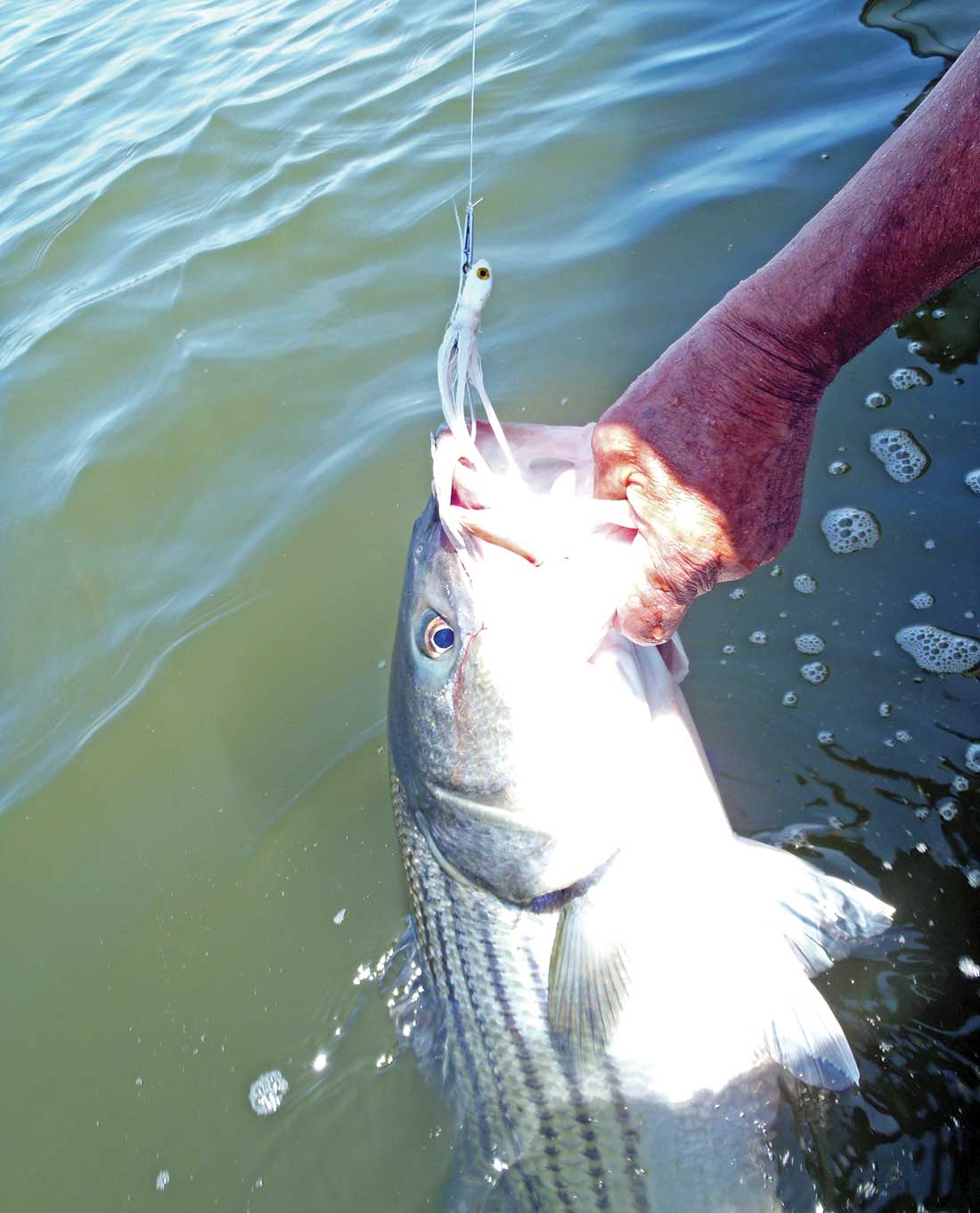
My rinds are also very skinny in spring. To achieve the narrow strips I prefer, I start with any style of rind. I use a sharp knife and trim the rind to length and then to width. Please be very careful if you try this, pay close attention to the process, and curl your finger tips under to keep them away from the blade. Let me provide an example. Although no longer in manufacture, let me use Uncle Josh 240-S as the example because it is easier to develop a mental picture of what the end result should look like. Besides, I know some of you stocked up before the end of production.
Anyway, start with a cross cut where the split tail meets the front of the rind. Now you have two pieces that are about 3 inches long. Taking one at a time, make a long tapering cut from the square front of the rind toward the rear end. If I remove a little of the rear of the tail; it’s fine, because a strip between 2 to 3 inches is the goal. By making these tail pieces skinnier, they are a better match to skinny sand eels and become much more flexible. Flexibility is important to me because sometimes, especially in cold water, I retrieve very slowly and I want the rind to wiggle no matter how slowly I retrieve. This is all conjecture, but I believe the bucktail grabs their attention and the pork rind looks like a sand eel or spearing, and that’s what triggers the hit.
Soft plastic lures are big producers in spring, too. Light weight lead-heads (1/2 to 1 ounce) seem to produce better than heavier ones, because of a slower sink rate, I believe. Don’t pooh-pooh this idea, because I have witnessed, again and again, how a slower sink rate in spring fishing produces more hits. I’ll get to retrieves in a bit, so hang in there. I use a variety of 3- and 4-inch soft plastics and my color palate consists of light colors: bone, pearl, chartreuse, and albino. Although I prefer paddle tail models most of the time, other narrow tail plastics are very good including Bass Assassin and Zoom Super Fluke Junior. There are other choices, but make sure the tails are thin enough and the plastic supple enough so that the tail jiggles a bit on a slow retrieve.
However, I use paddle tail models most of the time simply because the tail always moves regardless of the retrieve. There are many choices, but here are a few of mine. I prefer the Little Dipper from Reaction Innovations, the DieZel MinnowZ from Z-man, and the Cocahoe Minnow made by H & H Coastal Tackle. The Z-man is the most durable and the Little Dipper the most flexible, and each has its day in the field. All of these lures offer a long tubular profile that imitates spearing and sand eels. I also have Mister Twister 4-inch Sassy Shads, but because I want a tubular profile, I cut the bellies off and essentially create the same shape as the plastics mentioned above. In some years the bait is less than 2 inches, and I go “micro.” Mister Twister’s 3-inch Sassy Grub is my go-to micro plastic, but the 3-inch Sassy Shad is a very good choice, too. I use these plastics on half-ounce heads.
Presentations
Lure selection is only one piece of a presentation. Where you cast and how you retrieve is very important, too. Bucktails with pork rind and paddle tail lures wiggle regardless of the speed of retrieve, so I select one of these to start. In my opinion, an angler should begin with a moderate straight retrieve speed. That is, turn the reel handle to a one, two (said aloud slowly) rhythm. This retrieve will produce best most of the time. I’m often asked, “how do I know when to change my retrieve?” My reasons are simple. First, if I get no hits, and second if I get “bumps” but no hook-ups. A lack of hits tells me I’m probably in the wrong spot, but bumps tell me I’m close, but my presentation is not on target. My first change will be to keep the same speed but make a very short (less than a second) pause two or three times during the retrieve. This allows the lure to fall back momentarily and that’s when the strikes usually occur. If that fails, I go extreme. I’ll make a fast retrieve by sweeping my rod away from the lure, then quickly move the rod tip towards the lure while rapidly picking up the slack, and repeat this sequence over and over. Obviously, the lure is falling on the back-sweep, and jumping ahead on the forward sweep. Again, most of the time, the fish will strike on the fall. I believe this extreme presentation grabs their attention on the forward sweep and draws them to the lure. Then they hit the easy meal as it falls. These presentations are finesse techniques, and an angler should try a lot of variations of these retrieves in an attempt to lock in on the best response from the fish. One caution, however, is that the fish may change their moods during a tide cycle. Suppose sand eels that were swimming in a school a foot or two off the bottom suddenly dive and bury in the bottom. Stripers will root them out with their snouts, but the sand eels will dive back down quickly thus explaining why the extreme presentation works well.
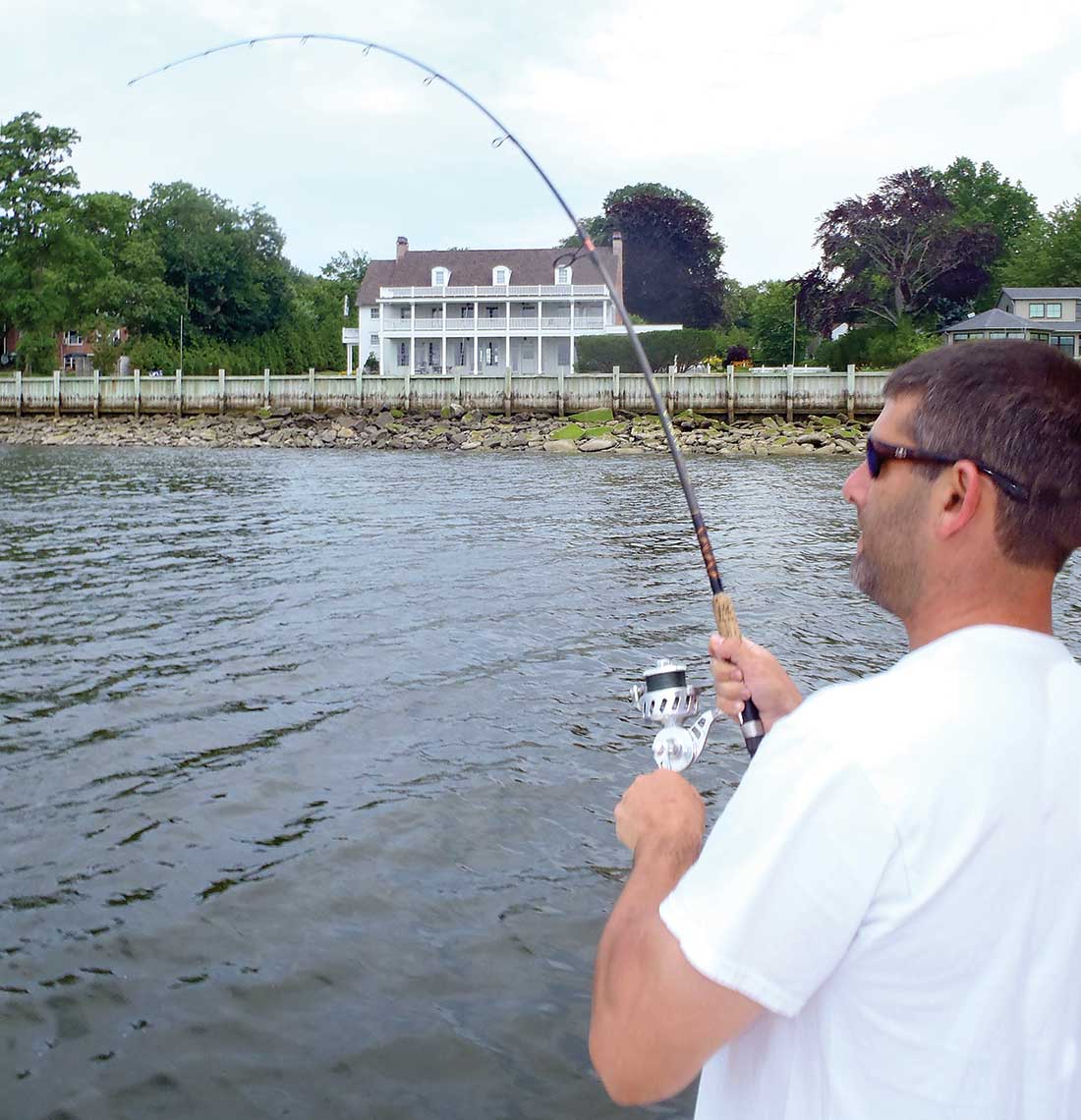
Tackle
Proper finesse presentations are difficult or impossible with heavy tackle. First of all, casting distance and accuracy are compromised. Second, heavy tackle doesn’t have enough “give” to allow light lures to move naturally. Light tackle has more flexibility, so there is a lag in response time. The lag produces a more fluid less jerky lure movement. I like a 7-foot medium power spinning rod with fast or extra-fast tip for finesse techniques. I use a Van Staal 150 with 15- or 20-pound test Sufix Performance Braid or J-Braid to round out my gear package.
The fish are there, the water is there, and hopefully the bait is there, so why not give this early season light tackle harbor fishing a try. It’s lots of fun and there’s usually little competition from other boats.

